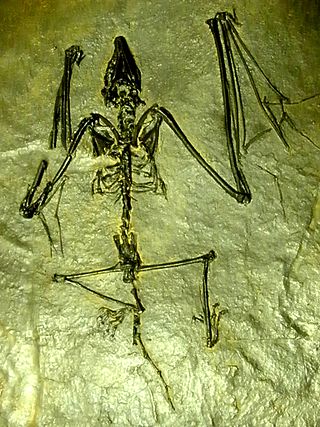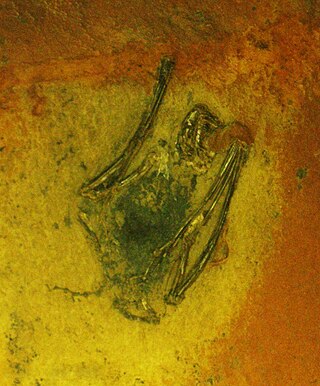
The Lacertidae are the family of the wall lizards, true lizards, or sometimes simply lacertas, which are native to Afro-Eurasia. It is a diverse family with at about 360 species in 39 genera. They represent the dominant group of reptiles found in Europe.

Leptictidium is an extinct genus of small mammals that were likely bipedal. Comprising eight species, they resembled today's bilbies, bandicoots, and elephant shrews, and occupied a similar niche. They are especially interesting for their combination of characteristics typical of primitive eutherians with highly specialized adaptations, such as powerful hind legs and a long tail which aided in locomotion. They were omnivorous, their diet a combination of insects, lizards, frogs, and small mammals. Leptictidium and other leptictids are not placentals, but are non-placental eutherians, although they are closely related to placental eutherians. They appeared in the Lower Eocene, a time of warm temperatures and high humidity, roughly fifty million years ago. Although they were widespread throughout Europe, they became extinct around thirty-five million years ago with no descendants, as they were adapted to live in forest ecosystems and were unable to adapt to the open plains of the Oligocene.

The Messel pit is a disused quarry near the village of Messel about 35 km (22 mi) southeast of Frankfurt am Main, Germany. Bituminous shale was mined there. Because of its abundance of well-preserved fossils of the Messel Formation dating from the middle of the Eocene, it has significant geological and scientific importance. Over 1000 species of plants and animals have been found at the site. After almost becoming a landfill, strong local resistance eventually stopped these plans and the Messel pit was declared a UNESCO World Heritage Site on 9 December 1995. Significant scientific discoveries about the early evolution of mammals and birds are still being made at the Messel pit, and the site has increasingly become a tourist site as well.

Diplocynodon is an extinct genus of alligatoroid crocodilian that lived during the Paleocene to Middle Miocene in Europe. Some species may have reached lengths of 3 metres (9.8 ft), while others probably did not exceed 1 metre (3.3 ft). They are almost exclusively found in freshwater environments. The various species are thought to have been opportunistic aquatic predators.

Cupes is a genus of beetles in the family Cupedidae. The Cupedidae are typical “reticulate” or “net-winged” beetles with incompletely sclerotized elytra that produce the characteristic reticulate appearance.

Macrocranion is a genus of extinct mammal from the Eocene epoch of Europe and North America. Exceptional fossils have has been found in the Messel Pit of Germany. Macrocranion species are often described as forest-floor predators, about the size of small squirrels but with longer limbs. The genus is represented at the Messel Pit site by two species, M. tupaidon and M. tenerum.

Allaeochelys is an extinct genus of Carettochelyid turtle, known from the Eocene to Miocene of Europe, Asia, North America and Africa.

Palaeopython is an extinct genus of snake from the Eocene of Europe. The genus has been used to refer to large Western and Central European snake vertebrae from the Eocene. P. cadurcensis and the tentatively-referred "P." neglectus originate from France; P. ceciliensis originates from Germany; and P. helveticus originates from Switzerland. A species known from multiple well-preserved specimens found in the Messel Pit of Germany, P. fischeri, was named by Stephan Schaal in 2004, but examination of the genus showed that it represented a distinct lineage; it was renamed Eoconstrictor fischeri in 2020 by Agustín Scanferla and Krister T. Smith. Another species from France, P. filholii, was moved to the genus Phosphoroboa in 2021 by Georgalis, Márton Rabi, and Smith. An additional species, P. sardus, was described in 1901 by Alessandro Portis from the Middle Miocene of Monte Albu. However, a reevaluation of the holotype specimen of this species revealed it to actually belong to an indeterminate acanthomorph fish.

Archaeonycteridae is a family of extinct bats. It was originally erected by the Swiss naturalist Pierre Revilliod as Archaeonycterididae to hold the genus Archaeonycteris. It was formerly classified under the superfamily Icaronycteroidea (disused) by Kurten and Anderson in 1980. In 2007, the spelling was corrected to Archaeonycteridae and it was reclassified to the unranked clade Microchiropteramorpha by Smith et al.. The family Palaeochiropterygidae was also merged into Archaeonycteridae by Kurten and Anderson, but modern authorities specializing in bat fossils maintain the distinction between the two.

Cryptolacerta is an extinct genus of lacertoid lizard which lived during the Eocene epoch in what is now Germany. It is known from a nearly complete and articulated skeleton including the skull, which was found in the Messel Pit locality of Germany. Cryptolacerta was named by Johannes Müller, Christy A. Hipsley, Jason J. Head, Nikolay Kardjilov, André Hilger, Michael Wuttke and Robert R. Reisz in 2011 and the type species is Cryptolacerta hassiaca. Cladistic analysis conducted by Müller et al. suggests that Cryptolacerta is a sister taxon to Amphisbaenia. However, later studies questioned its closeness to that group, and suggested that the similarities could be convergent due to both groups having a similar burrowing lifestyle, and it may be more closely related to Lacertidae instead.

Saniwa is an extinct genus of varanid lizard that lived during the Eocene epoch. It is known from well-preserved fossils found in the Bridger and Green River Formations of Wyoming, United States. The type species S. ensidens was described in 1870 as the first fossil lizard known from North America. A second species, S.orsmaelensis, is recognised from remains found in Europe. It is a close relative of Varanus, the genus that includes monitor lizards.

Buxolestes is an extinct genus of semi-aquatic, non-placental eutherian mammals belonging to the family Pantolestidae. Species in this genus were part of the first placental evolutionary radiation during the Middle Eocene and found in the Bracklesham Group and Wittering Formation of England, at the Messel Pit in Germany and in Bouxwiller, France.

Shinisauria is a clade or evolutionary grouping of anguimorph lizards that includes the living Chinese crocodile lizard Shinisaurus and several of its closest extinct relatives. Shinisauria was named in 2008 by Jack Lee Conrad as a stem-based taxon to include all anguimorphs more closely related to Shinisaurus than to Anguis fragilis, Heloderma suspectum or Varanus varius. Several recent phylogenetic analyses of lizard evolutionary relationships place Shinisauria in a basal position within the clade Platynota, which also includes monitor lizards, helodermatids, and the extinct mosasaurs. Shinisaurians were once thought to be closely related to the genus Xenosaurus, but they are now considered distant relatives within Anguimorpha. The fossil record of shinisaurians extends back to the Early Cretaceous with Dalinghosaurus, which is from the Aptian aged Yixian Formation of China. Two other extinct shinisaurians are currently known: Bahndwivici from the Eocene of Wyoming and Merkurosaurus from the Late Oligocene of Germany and the Early Miocene of the Czech Republic. An indeterminate shinisaurian is known from an isolated tail found in the Eocene aged Messel pit in Germany.
Suzanniwana is an extinct genus of iguanian lizards that lived in western North America during the earliest Eocene, approximately 56 million years ago. Two species are known from the Bighorn Basin of Wyoming: the type species S. patriciana named in 2009, and the species S. revenanta named in 2013. Suzanniwana lived during the Paleocene–Eocene Thermal Maximum, a brief period of global warming that resulted in warmer and drier conditions in the Bighorn Basin. It likely stemmed from a lineage that had migrated into the basin from regions farther to the south, following a latitudinal band of constant climatic conditions that moved northward as the planet warmed. Suzanniwana shares many skeletal features with modern casquehead lizards of the family Corytophanidae and may be a stem-corytophanid. It also closely resembles Geiseltaliellus, an iguanian from the middle Eocene Messel pit in Germany.
Geiseltaliellus is an extinct genus of iguanian lizards that lived in what is now western Europe during the Eocene. It belongs to the family Corytophanidae, which includes modern casquehead lizards. Many fossils are known from Germany, France, and Belgium, with the most well preserved coming from the Messel pit lagerstätte in Messel, Germany. German paleontologist Oskar Kuhn named the genus in 1944 after the Geiseltal valley where the first specimens were found, designating the type species Geiseltaliellus longicaudus. Three new species — G. louisi, G. lamandini, and G. grisolli — were named in the 1990s and 2000s on the basis of more fragmentary remains from France and Belgium, although G. louisi has since been synonymized with G. longicaudus. In 2009 the Messel pit specimens were recognized as belonging to a species distinct from that of the G. longicaudus specimens in Geiseltalt and were collectively reclassified under a new name, G. maarius.

Messelasturidae is an extinct family of birds known from the Eocene of North America and Europe. Their morphology is a mosaic that in some aspects are very similar to modern hawks and falcons, but in others are more similar to parrots. Initially interpreted as stem-owls, more recent studies have suggested a closer relationship to parrots and passerines. Their ecology is enigmatic.

Palaeovaranidae, formerly known as Necrosauridae, is an extinct clade of anguimorph lizards known from the Paleogene of Europe. They have sometimes been recovered as members of Varanoidea. It contains three genera.

Hassianycteris is an extinct genus of Early Eocene (Ypresian) to Middle Eocene (Lutetian) bats from the Hassianycterididae with four or five known species: the type, H. magna, and H. revilliodi, all found in the Messel pit, Germany, H. kumari, found in the Cambay Shale Formation, India, and the possible fifth species "H." joeli, found in the Kortijk Clay Formation, Belgium, which may instead belong to Onychonycteridae. The Messel bats Palaeochiropteryx and Hassianycteris are the first fossil mammals whose colouration has been discovered: both were reddish-brown when alive.

Paranecrosaurus is an extinct genus of lizard from the Eocene Messel Pits of Germany. It contains a single species, Paranecrosaurus feisti, originally described as a species of Saniwa. It was carnivorous, as indicated by the presence of the lizard Cryptolacerta as stomatch contents. It is placed in the family Palaeovaranidae.
This is an overview of the paleofauna of the Eocene Messel Formation as explored by the Messel Pit excavations in Germany. A former quarry and now UNESCO World Heritage Site, the Messel Formation preserves what once were a series of anoxic lakes surrounded by a sub-tropical rainforest during the Middle Eocene, approximately 47 Ma.
















